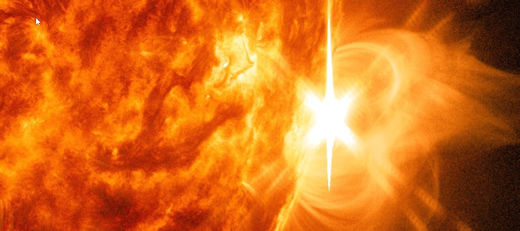
An #X1-class solar flare on the #sun. A #superflare could be hundreds of times stronger
X-ray #Solar #Flares
6-hr max: M2 1124 UT Dec13
24-hr: M2 1743 UT Dec12
https://spaceweather.com/
One person like that

An #X1-class solar flare on the #sun. A #superflare could be hundreds of times stronger
X-ray #Solar #Flares
6-hr max: M2 1124 UT Dec13
24-hr: M2 1743 UT Dec12
https://spaceweather.com/
https://www.youtube.com/watch?v=vsLzoR8qPPQ
BLIZZARD WARNING‼️ Strong Solar Flare / Earthquake WATCH‼️⚠️
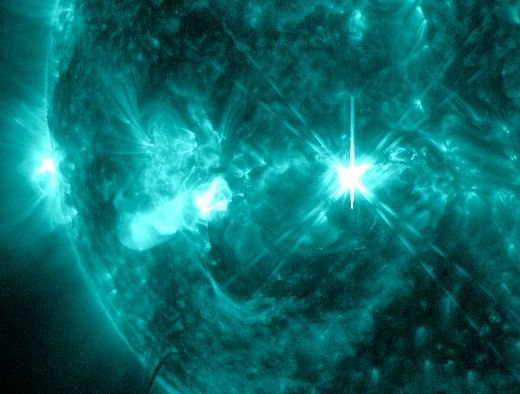
STRONG #FLARES ARE #UNDERWAY: Solar activity has reached high levels on Nov. 6th as sunspots AR3883 and AR3886 crackle with strong solar flares. The most powerful so far is this #X2 -class explosion centered on AR3883:
Extreme UV radiation is ionizing the top of Earth's atmosphere, causing shortwave radio blackouts. Ham radio operators DXing across the southern hemisphere may notice intermittent loss of signal below 30 MHz.
There's a good chance that one or more CMEs are heading for #Earth
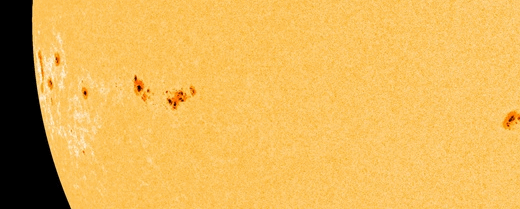
COMPLEX SUNSPOTS ARE TURNING TOWARD EARTH: NOAA forecasters estimate a 35% chance of an X-class solar flare today. If so, it will probably come from one of these sunspots now turning toward Earth:
Numbered AR3883 and AR3886, the two active regions are unusually complex. The trailing group (3886) looks more like a shotgun blast than an ordinary sunspot, with more than 10 scattered dark cores. Mixed-polarity magnetic fields arcing between those cores could easily reconnect and explode.
#X-ray #Solar #Flares
6-hr max: M5 0850 UT Nov06
24-hr: M5 0850 UT Nov06
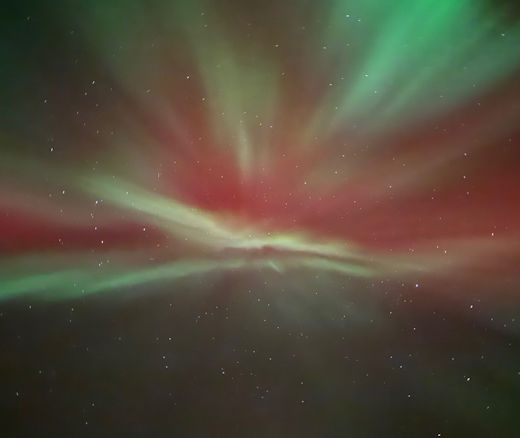
THE #SKY EXPLODED': A CME gently grazed Earth's magnetic field on Oct. 26th. At first it seemed like nothing would happen. Then, "the sky exploded," says Terence Murtagh, who took this picture using his iPhone 16 outside Tromso in #Norway:
"In many decades of viewing and photographing #auroras, I've never seen so many spectacular bright multicoloured coronas bursting over the sky," he says. "I couldn't believe my eyes as a small group of us were transfixed by this cosmic kaleidoscope. It was probably caused by the tail of the weak CME.
#X-ray #Solar #Flares
6-hr max: C8 0324 UT Oct27
24-hr: M8 0820 UT Oct26
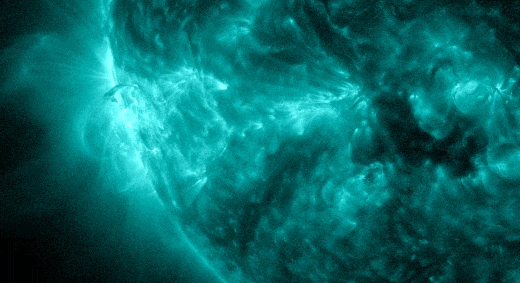
#X-CLASS #SOLAR #FLARE: Emerging #sunspot AR3869 erupted this morning (Oct. 24th @ 0357 UTC), producing a slow X3.3-class solar flare. NASA's Solar Dynamics Observatory recorded the hour-long flash:
X-ray Solar #Flares
6-hr max: X3 0357 UT Oct24
24-hr: X3 0357 UT Oct24
Extreme #ultraviolet #radiation from the flare ionized the top of #Earth's atmosphere. This, in turn, caused a shortwave radio blackout over Australia and Southeast Asia. Ham radio operators may have noticed loss of signal at frequencies below 30 MHz for as much as an hour after the flare.
This explosion almost certainly produced a #CME. The US Air Force is reporting a Type II solar radio burst, a natural signal that comes from shockwaves at the leading edge of CMEs. Characteristics of the burst suggest a CME traveling 1.3 million mph.
#X-ray #Solar #Flares
6-hr max: X1 1547 UT Oct09
24-hr: X1 0156 UT Oct09
https://youtube.com/watch?v=NHWKW4x3U80
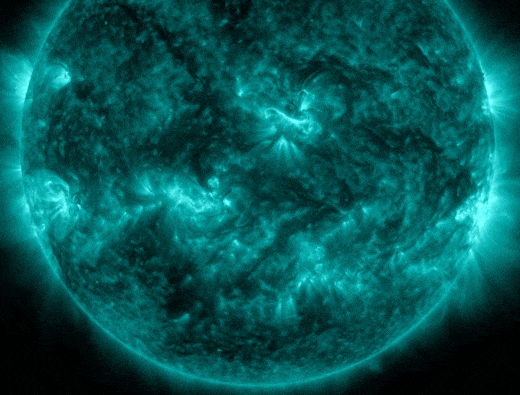
#X-CLASS SOLAR #FLARE: #Sunspot AR3848 was directly facing #Earth this morning, Oct. 8th (0156 UTC), when it unleashed a powerful X1.8-class solar flare. NASA's Solar Dynamics Observatory recorded the extreme #ultraviolet #flash:
This explosions lasted more than 4 hours, so long that it lifted a massive CME out of the #sun's atmosphere. Take a look at these preliminary coronagraph images from NASA's STEREO-A spacecraft. This #CME will certainly hit Earth later this week, potentially sparking a new round of geomagnetic storms.
#X-ray #Solar #Flares
6-hr max: C8 0730 UT Oct09
24-hr: X1 0156 UT Oct09
explanation | more data
Updated: Today at: 1255 UT
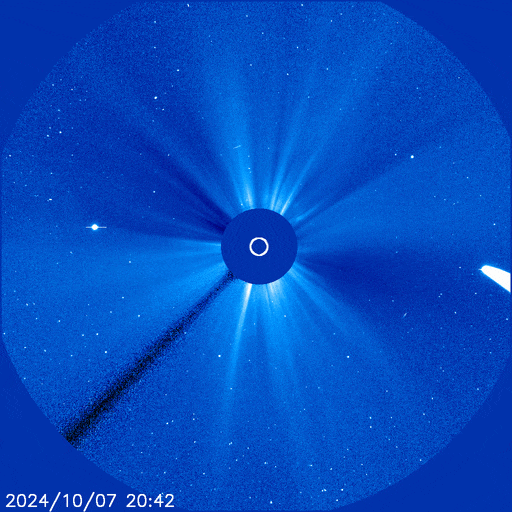
#CME COULD HIT #EARTH AND #COMET T-ATLAS: SOHO coronagraphs are obtaining some remarkable images today. One of the brightest comets in decades, Comet Tsuchinshan-ATLAS (C/2023 A3), is passing through the field of view while the sun emits a series of bright CMEs. The first CME in this movie appears to be on course to hit both Earth and the comet:
Hurled into space by a powerful X2-class solar flare on Oct. 7th, the CME could strike the comet later today or perhaps early on Oct. 9th, The impact could actually rip off the comet's tail. The same thing happened to Comet Enke in April 2007. A broken tail is something astronomers should look for when Comet Tsuchinshan-ATLAS emerges from the sun's glare later this week.
According to a NASA model, the CME will graze Earth late on Oct. 9th or early on Oct. 10th. The impact could cause a another geomagnetic storm with auroras at mid-latitudes in the USA and Europe. NOAA analysts are looking at this CME now and may soon issue a refined forecast
#X-ray #Solar #Flares
6-hr max: C5 1750 UT Oct08
24-hr: X2 1913 UT Oct07
CHANCE OF MORE X-FLARES TODAY: The solar disk is filled with big sunspots. Three of them (3842, 3843, 3848) have unstable 'delta-class' magnetic fields that harbor energy for strong solar flares. NOAA forecasters estimate a 75% chence of M-class flares and a 35% chance of X-flares during the next 24 hours.
#X-ray #Solar #Flares
6-hr max: M1 0825 UT Oct05
24-hr: M1 0825 UT Oct05
explanation | more data
Updated: Today at: 1200 UT
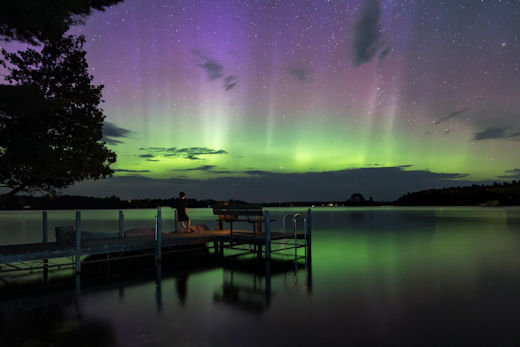
#auroras over Minnesota:
"My grandson is a huge space weather enthusiast and he was thrilled to watch the beautiful Northern Lights with me tonight," says photographer Greg Ash of Ely, MN. While Ash's family watched the display from Minnesota, photographic red auroras descended as far south as Nebraska.
Minor storming is expected to continue as Earth moves through the magnetized wake of these CMEs. Storm levels could jump to category G2 if another CME arrives on Aug. 1st,
THE #SUN IS LITERALLY CRACKLING WITH #FLARES: Seldom is the sun peppered with so many unstable sunspots. Today, there are at least 7 active regions capable of producing strong Earth-directed solar flares. This time-compressed movie shows the past 24 hours of explosions:
All of these are strong M-class solar flares. An even stronger X-flare may be in the offing with radio blackouts and perhaps a CME
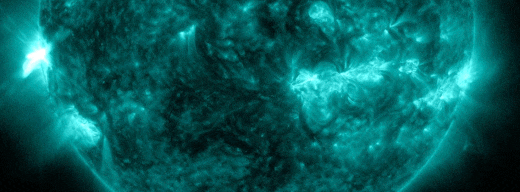
X-ray #SolarFlares
6-hr max: M8 0709 UT Aug01
24-hr: M8 0709 UT Aug01
https://spaceweather.com/
#X-ray #Solar #Flares
6-hr max: #X4 0635 UT May06
24-hr: X4 0635 UT May06
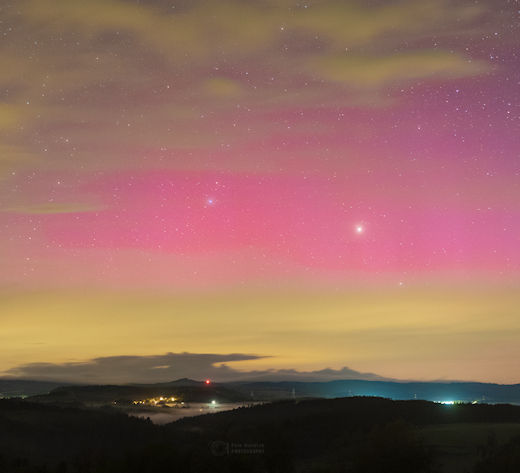
A #CME expected to hit #Earth on May 5th appears to have arrived right on time. Solar wind data suggest a close encounter around 1800 UT in good accord with NASA and NOAA predictions. The resulting G1-class geomagnetic storm sparked mid-latitude auroras in Europe:
" #Auroras surprisingly appeared here in the Czech Republic at latitude +50 N," reports photographer Petr Horálek at the Institute of Physics in Opava. "They were visible to the naked eye despite the cirrus clouds."
This might not have been a direct hit. Normally, on-target CMEs produce a sharp discontinuity in the speed of solar wind blowing around our planet. Not this time. Instead, a gentle ripple of south-pointing magnetism washed over the Earth for several hours--typical of near-miss CMEs that catch us in their wake.
More CMEs may be on the way. Yesterday's flurry of X- and M-class solar flares from hyperactive sunspot AR3663 probably hurled some debris toward Earth. Confirmation awaits overdue coronagraph data from SOHO
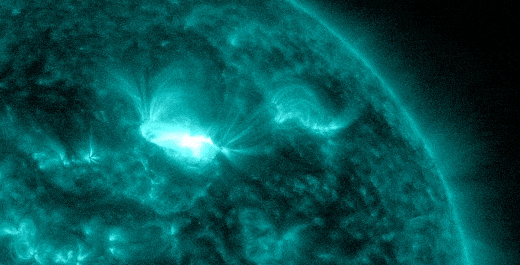
MOST ACTIVE #SUNSPOT IN YEARS: Fast-growing sunspot AR3663 has quickly become the most active sunspot of Solar Cycle 25. Today alone it has unleashed two #X-flares and six #M-class #flares. This interest-compressed movie from the #Solar Dynamics Observatory shows 12 hours of crackling action:
Each of these flares has created a brief but deep radio blackout on Earth, causing loss of signal at frequencies below 30 MHz. These are events easily noticed by ham radio operators, aviators and mariners using shortwave to communicate.
The flares are expected to continue. AR3663 has a 'beta-gamma-delta' magnetic field where mixed polarities are bumping together in explosive proximity. NOAA forecasters estimate a 75% chance of additional M-class flares and a 25% chance of more X-flares on May 5th.
https://spaceweather.com/
Activists hung a huge Palestinian flag from the Leaning Tower of Pisa in Italy and lit smoke flares as they staged a protest to condemn Israel’s bombardment ...#Activists #AlJazeera #AlJazeeraEnglish #Gaza #Israels #LeaningTowerofPisa #Palestinian #Pisa #alJazeera #aljazeeraEnglish #aljazeeralive #aljazeeravideo #aljazeeraEnglish #aljazeeralatest #aljazeeralive #aljazeeralivenews #bombardment #ceasefire #condemn #flag #flares #latestnews #newsheadlines #protest #smoke
Palestinian flag hung from Leaning Tower of Pisa | AJ #shorts

NEW SOURCE OF FLARES: Suddenly, AR3445 is crackling with activity. The mixed-polarity sunspot has produced multiple #M-class #flares this weekend, including this M4-category explosion on Sept.24th (0328 UT):
A flash of extreme #ultraviolet #radiation from the #flare ionized the top of Earth's atmosphere, causing a shortwave radio blackout over #Australia: map. Mariners and ham radio operators may have noticed loss of signal at frequencies below 25 MHz for as much as 30 minutes after the flare.
This flare might have lasted long enough to lift a #CME out of the sun's atmosphere.
https://spaceweather.com/